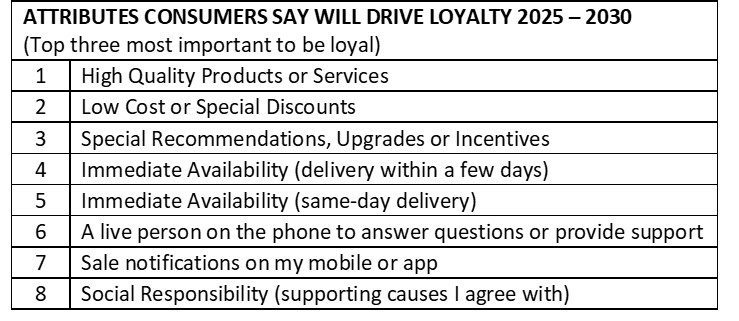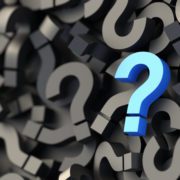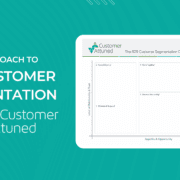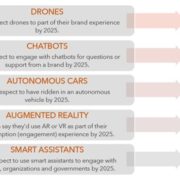Consumer Loyalty 2030
Drivers of loyalty are also drivers of profitable business
I’ve recently been reading the SAS / Futurum “Experience 2030” report, and its question regarding what will drive customer loyalty in the future grabbed my attention.
Customer loyalty can mean different things to different people. It is argued that in the past consumers were almost blindly loyal to brands, with repeat-purchase the easiest option / route of least resistance, but in the new “customer empowered” age instant, easy browsing with recommendation-driven prompting is increasingly eroding loyalty. There is real merit in this argument, making it vital for companies to understand how to win and keep loyalty in this new empowered landscape.
What is loyalty?
Customer loyalty theory boils down into two different aspects:
- Behavioural loyalty – customers repeat purchasing your brand / product. This is sometimes referred to as “continuity”, as it could be simple convenience that drives this behaviour, or customer “inertia” (can’t be bothered to switch) – neither could hardly be described as loyalty!
- Attitudinal loyalty – usually described as some sort of ladder with ‘trial buyers’ at the bottom and ‘advocates’ or ‘fans’ at the top. Some CX practitioners are of the opinion that if you “wow” customers enough you’ll make them advocates (high NPS) or fans (with your brand metaphorically tattooed on their arms). There’s merit in this argument, but we can’t automatically assume that high attitudinal loyalty equals your “best” (i.e. most profitable) customers – that depends on their spending power. We also can’t assume advocacy higher up the ladder – studies have shown that new customers are just as likely to recommend a brand if their purchase experience was good
I hope that you see from this (perhaps over-simplified) description that a brand needs BOTH attitudinal and behavioural loyalty to be sustainably successful.
For business value to be delivered, I hope it’s also clear that behavioural loyalty keeps the bread on the table.
It is sobering to realise that some of your most profitable customers (high continuity with low cost-to-serve) may have little or no attitudinal loyalty. These customers may well consider moving their business to a new entrant or more convenient provider if the competitive offer is sufficient to overcome inertia.
What drives loyalty?
The question in the SAS / Futurum “Experience 2030” report is clearly more focused on behavioural loyalty, asking for “up to THREE features you believe will be most important to you in deciding to be loyal to a brand or organization”. The results give eight attributes that consumers say will drive loyalty in the future:

High quality is top of the list. It’s worth reminding ourselves that ‘quality’ is not necessarily about ‘premium’ or ‘luxury’. In its most rudimentary definition, it’s about delivering what was ordered on-time, on-cost and to the required specification – very much about getting the basics right. ‘High’ quality is doing it well! If you can consistently deliver what you promised when you promised it at a reasonable price then you stand a chance of building both attitudinal and behavioural loyalty. It’s not sexy like CX delight theory, but it earns you the right to go on and build and deepen the relationship.
The features that come 2nd, 3rd and 7th are very transactional, and consumers are confirming that their behaviour can be influenced by offers if they’re well-made and appropriate. This very much speaks to the need for providers to excel in real-time personalisation. Companies will build loyalty if they can truly understand customer needs and propensity, and then meet individual customers on their journeys to make relevant value-adding offers.
Expectations for quick or immediate delivery have soared in recent years, and the fact that they come 4th and 5th on the list shows how empowered consumers now are. Providers used to specify what “on-time” meant. Customers can now easily decide if that’s not good enough and switch provider.
The 6th most important feature – live person interaction – is a timely reminder to companies dashing for digital transformation that they mustn’t lose the human touch. There was a chatbot option in the question but it didn’t make the top eight. Should we scrap our digitisation plans? NO! What we should do is have equal weighting in those plans for CX and cost efficiency. Transformations that ignore CX in favour of cost savings will lead to customers feeling like they’re just a number and that they’re being ‘processed’ rather than engaged. Good “design thinking” is always CX-driven and should always address attitudinal and behavioural loyalty.
The final feature on the list (social responsibility) is the only one that’s purely attitudinal. Brand image didn’t even make the cut! This is definitely one to watch, particularly with respect to climate and environmental issues. Even highly loyal customers will reconsider that loyalty if you’re caught out by something that society deems as irresponsible e.g. single use plastics.
What about loyalty programmes?
 It’s interesting to note that one of the options in the question – VIP (loyalty) programmes – also didn’t make the top eight. This is a fascinating finding in its own right. It suggests that consumers are beginning to twig that they can get a better/cheaper/quicker-delivered deal by shopping around than by sticking with an existing provider and getting a retrospective “reward”.
It’s interesting to note that one of the options in the question – VIP (loyalty) programmes – also didn’t make the top eight. This is a fascinating finding in its own right. It suggests that consumers are beginning to twig that they can get a better/cheaper/quicker-delivered deal by shopping around than by sticking with an existing provider and getting a retrospective “reward”.
Is this the death-knell for loyalty programmes? I suspect not as they are often an economic vehicle by which many of the features that did make the top eight are offered. Simple spend-related programmes are now ubiquitous. My advice is that if you are considering launching or re-engineering a loyalty programme then it needs to be something very special and truly innovative.
Loyalty isn’t a tactic!
The conclusion in the SAS / Futurum “Experience 2030” report regarding ‘Loyalty in the Digital Age’ is that we need to change our thinking to “be a loyalty company, not loyalty programme”.
I wholeheartedly endorse this as it speaks to an organisation and culture that builds and celebrates both attitudinal and behavioural loyalty. This can only be achieved by being systemically customer centric and insight-led, deploying innovative design-thinking approaches to our transformation programmes.
We can thereby avoid an acquisition-hungry, high-churn toxic environment of ever-increasing sales and market share targets from an ever-diminishing cohort of customers who haven’t yet considered our brand.
Please get in touch if you would like a deeper conversation about loyalty, or with SAS UK to see how their tools and expertise in customer behaviour and loyalty analytics can help you.
This unpaid-for blog was authored by Peter Lavers as part of the SAS Collaborators Programme.
- Should you implement NPS in B2B? - January 22, 2025
- B2B Trust as a Predictive Indicator - November 12, 2024
- Relationship Crises and Trust - October 2, 2024






